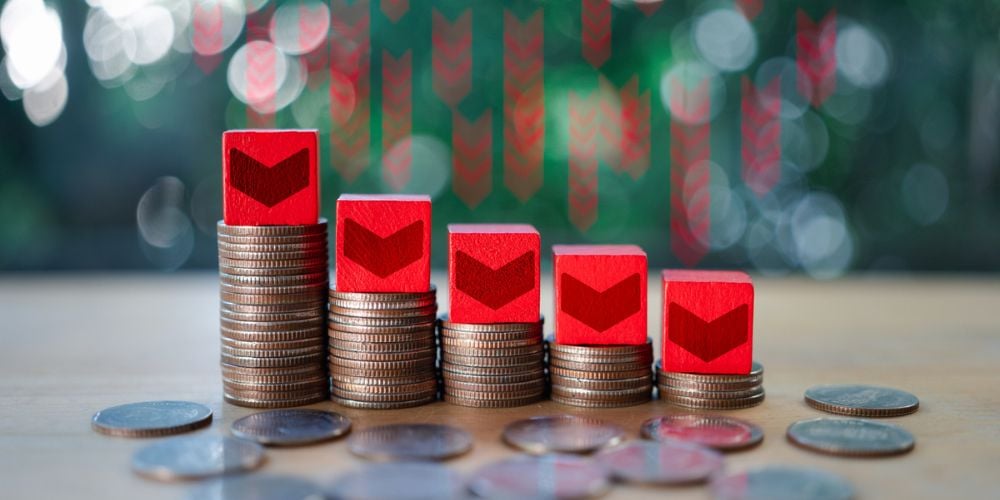Deflation, often seen through a lens of caution and concern, presents a complex narrative in the tapestry of economic policy and growth.
Unlike its counterpart, inflation, deflation signals a general decrease in the price level of goods and services within an economy. This phenomenon, while may initially seem beneficial, harbors implications that can significantly impact economic vitality and growth. So, is deflation bad for economic growth? let’s learn the easy way.
Understanding Deflation
Definition and Explanation
At its core, deflation reflects a decline in the price levels across an economy. This concept stands in contrast to inflation, which signifies rising prices.
The distinction is crucial as each phenomenon can lead different trajectories in economic health and policy implications.
Causes of Deflation
The roots of deflation can sprawl across several factors. Overproduction, sparking a surplus of goods, alongside a decrease in demand, can initiate deflationary pressures.
Technological advancements that reduce production costs can also lead to lower prices. Additionally, a contraction in the money supply or an increased demand for cash can spur deflation.
Is Deflation Bad for Economic Growth?
The impact of deflation extends across consumer behavior, business investment, and the delicate balance of debt dynamics.
Consumers, anticipating further decreases in prices, might postpone purchases. This hesitation can result in a formidable cycle where demand continues to drop, forcing businesses to slash prices further.
From a business perspective, falling prices can translate to diminished revenues, potentially leading to workforce reductions and curtailed investments. The anticipation of lower prices in the future dampens the appeal of investing today, stagnating economic growth.
In the realm of debt, deflation escalates the real value of debt. As prices drop, the relative burden of repayment grows, creating a more challenging financial landscape for borrowers.

The Complex Relationship Between Deflation and Economic Growth
Historical Perspectives
History offers insight into deflation’s intricate dance with economic growth. The Great Depression and Japan’s “Lost Decade” provide stark examples of how prolonged deflation can entrench economies in periods of stagnation and decline.
Short-Term vs. Long-Term Effects
In the short term, deflation might not wield immediate harm and can even offer benefits, such as increased purchasing power.
However, the long-term outlook often reveals a more dire consequence, where sustained deflation can cripple economic growth.
Different Types of Deflation
Not all deflation carries the same level of concern. Deflation arising from positive supply shocks, such as technological advancements, can be benign.
Conversely, deflation driven by demand shocks poses a more significant threat to economic health.
Policies to Combat Deflation and Its Impact on Growth
To counteract deflation, governments and central banks can deploy various strategies. Monetary policy tools, like lowering interest rates and quantitative easing, aim to spur spending and investment.
Conversely, fiscal policy levers, including government expenditure and tax incentives, seek to invigorate demand directly.
Pro Tips for Understanding Deflation’s Impact
When examining deflation, it’s essential to consider the broader economic context. The rate and persistence of deflationary trends, alongside distinctions between consumer goods and asset prices deflation, offer a nuanced view of its impacts.
Assessing government and central bank policies further illuminates the potential paths for navigating out of deflationary periods.
Case Studies
Japan’s experience in the 1990s underscores the perils of prolonged deflation, marked by economic stagnation and a challenging path to recovery.
The Eurozone’s dealings post-2008 financial crisis further highlight the complexities of addressing deflation within diverse economic frameworks.

Frequently Asked Questions
Why is deflation often seen as a negative economic indicator?
Deflation signals a decrease in demand and can lead to a vicious cycle of postponed consumption and investment, hindering economic growth.
What are the signs that an economy might be entering a deflationary period?
Signs include a consistent decrease in prices across a broad range of goods and services, alongside reduced consumer spending and investment.
Can deflation ever be positive for the economy?
In some cases, such as when driven by technological advancements, deflation can be benign, reflecting increased efficiency and potential for growth.
How does deflation affect average consumers and savers?
Consumers may benefit from lower prices in the short term, but the broader impacts of deflation can lead to economic stagnation, affecting jobs and income. For savers, the real value of debt increases, making loans and mortgages more burdensome.
What measures can policymakers take to prevent or counteract deflation?
Policymakers can utilize monetary and fiscal strategies to stimulate demand, such as lowering interest rates, quantitative easing, increased government spending, and providing tax incentives.
How does deflation affect interest rates and borrowing?
Deflation often leads to lower interest rates as part of central bank strategies to encourage borrowing and spending. However, the increased real value of debt can make borrowing less attractive.
When has deflation been successfully managed in an economy’s history?
Instances of successfully managing deflation are rare, given its challenging nature, but timely and decisive policy actions have mitigated its impacts in some scenarios, such as the U.S. response to the 2008 financial crisis.
Are there industries that benefit from deflation?
Some sectors, like technology, may experience growth due to deflationary pressures driving innovation and efficiency, though these benefits are often sector-specific.
The exploration of deflation and its relation to economic growth requires a thorough understanding and a strategic policy approach to mitigate its potential harms.
Through historical insight and proactive measures, economies can navigate the challenges posed by deflation, aiming for a balanced path of growth and stability.
Conclusion
Deflation intricately weaves through the fabric of an economy, presenting a complex challenge to sustained economic growth.
Through careful analysis and responsive policies, economies can navigate the deflationary landscapes they may encounter.


 Tags:
Tags:










